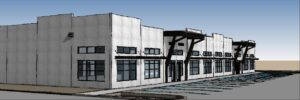As a structural engineer, it took inspecting concrete myself to really appreciate the importance of sealants in concrete structures. During a previous job a few years ago, I was given the task of inspecting concrete parking garage structures. Not the thrilling task I had in mind when I graduated as a structural engineer. Concrete structures can be cold and dusty.
Fortunately, my mentor had an appreciation for these types of structures which was passed on to me in time. I realized with concrete structures, there’s more than meets the eye. Despite starting out thinking of them as boring, I’ve come to appreciate concrete structures and the role sealants play in keeping the structures we work so hard to engineer as structurally sound as possible.
Reinforced Concrete
Concrete structures are made by using concrete and steel. This combination makes the best use of the compressive characteristics of concrete and the tensile strength of steel. Steel, despite being embedded in the concrete, is still vulnerable to corrosion. This shortcoming is overcome by protecting the steel in different ways. The most common way is to treat the steel bar with an epoxy coating prior to embedding the steel in the concrete. There are other indirect ways to protect the steel that are as important as the epoxy on the steel. Unfortunately once the steel is buried, it’s often thought that no more protection is needed. Too often, as the old saying goes: out of sight, out of mind.
Waterproofing
Waterproofing is the process of creating a barrier to keep moisture away from materials that are not supposed to be wet. Water in the form of rain, or even worse, deicing solutions during winter, can seep through concrete if the concrete isn’t properly sealed. If moisture finds its way to the steel, corrosion starts. When steel corrodes, rust expands, creating stresses in the concrete. That stress induces cracks for water to find its way directly to the steel, making the problem worse. Waterproofing sealant on concrete is vital for preventing or minimizing this cycle.
Preventive Measures
To protect the steel once concrete is set, a few simple tasks can be done for those who aren’t happy to let it be out of sight and out of mind. Preventative options include application of beads of sealant on cracks, cove sealants where the slab and wall meet, or a coat of sealant on the surface. A more advanced preventive measure is to use cathodic protection, where an anode is connected to a section of the steel in the concrete acting as the sacrificial piece to corrode instead of the primary steel in the concrete. But above all, avoiding puddles of water forming on the surface will be the most beneficial measure one can provide to extend the life of reinforced concrete.
If you’re looking for a team that understands the importance of the full life cycle of your building, let us know. Our multidisciplinary team is here to help!
If you want to learn more about related topics, check out these blog posts:










